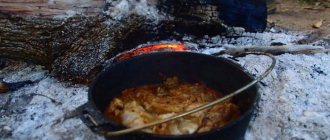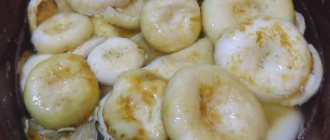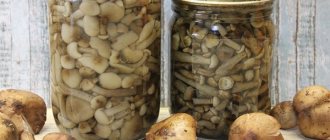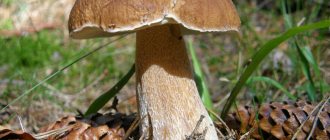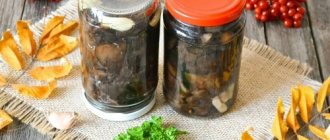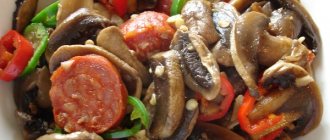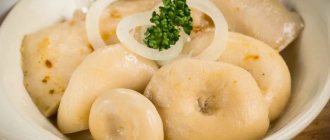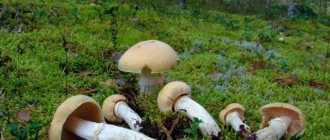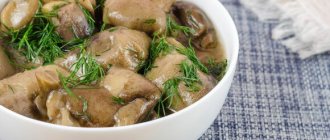Not robust or handsome in appearance, this mushroom is nevertheless valued by connoisseurs primarily for its unique, unique taste. Assembling it is also a pleasure: in an hour you can fill the bucket, literally without leaving your spot. Its nutritional value is in no way inferior to champignon; in a number of countries it is considered a delicacy. Meet the ringed cap - a little-known but respectable gift of nature.
Rozites caperata is a tasty edible mushroom.
The main parts of the fruiting body look like this.
- At the beginning of development, the cap has a hemispherical shape, drooping and slightly turned down edges, and a silver or matte white color, like waxed skin. As it grows, it becomes flat-convex, with a hump, its edges rise, and during dry periods it can crack. The skin becomes slightly wrinkled, fibrous with a powdery coating, its color changes to yellow-brown with a pinkish tint. In diameter from 5 to 12 cm.
- The pulp is white, slightly watery, dense, fibrous, with a characteristic taste reminiscent of meat. It does not change color when cut and has no specific odor. Susceptible to worms.
- The plates are attached to the stalk, sparse, and have jagged points. Their color is: white - in young specimens, clay-brown with an ocher tint - in mature and old ones. The spores have the shape of an egg or an ellipse. Rust-colored spore powder.
- The leg is up to 12 cm high, about 3 cm in diameter, dense, cylindrical in shape, somewhat thickened at the base. It is characterized by the presence of a film membrane (cortina), which, when ruptured, forms a ring that tightly fits the leg. Above the ring, the surface of the stalk is slightly scaly.
The ringed cap is also known under other names:
- chicken mushrooms;
- Turk;
- white marshweed;
- Rosites dull;
- cap.
Ringed cap
The cap mushroom is ubiquitous and grows almost everywhere.
The cap is called differently, chicken mushrooms, Turkish mushrooms, forest champignons... Heavy, strong mushrooms appear in July and are found until the end of September. Annular caps grow everywhere and often in large groups; they are found in humid mixed forests and birch groves, pine forests among blueberries…. In Europe, ringed caps are recognized as a delicacy, but in Russia they are considered toadstools. Indeed, the appearance of the caps does not inspire confidence, they are still handsome! And the mushroom is 100% edible; you don’t even need to cook it for frying. Ringed cap photo and description
Small mushrooms have a cap-shaped cap, apparently this is where the name comes from. In mature ones (10 - 15 cm), the hat is flat-convex with a blunt central tubercle. The color of the cap is of different shades, from light yellow to ocher, with a characteristic powdery coating in the central part. Mature fungi have wrinkled caps and often wavy edges. The pulp is quite fragile, white, then pale yellow, the color does not change when cut. The plates of young mushrooms are beige, while those of old ones seem to be rusty in color. The light legs, slightly thickened at the bottom, are decorated with a short (toadstool) skirt. The membranous ring is special, ribbed on top and very mobile, not attached to the stem. Despite its unsightly appearance, the ringed cap has a subtle anise smell and a good taste. Not white, of course, but salted, pickled ringed cap is much tastier than bitter mushrooms or russula. In gastronomic terms, cap mushrooms are universal mushrooms; you can marinate, salt, fry, cook soup, make mushroom caviar…. Any cooking recipes are good for them!
How to pickle a ringed cap
Pickling the ringed cap is no more difficult than other edible mushrooms and peeling the mushroom is easy. The dirty part of the stem is cut off and the ring under the cap is removed; larger hats are cut into halves or quarters, and the legs into rings. Pickling the ringed cap is no more difficult than other edible mushrooms. Although it is better to marinate small, unopened, egg-shaped mushrooms, they do not fall apart, the marinade is light and the caps are tasty and crispy
Marinade recipe:
- Per liter of water
- 9% table vinegar - 100 ml.
- Clove buds - 3 pieces
- Allspice - 3 pcs.
- One bay leaf
- Black pepper - 8 pcs.
- Sugar - 70 g.
- Salt - 30 g.
Marinate the ringed cap. Mushrooms prepared for pickling are rinsed with running water. Boil water in an enamel pan, lower the caps and cook for twenty minutes, then place in a sieve or colander and quickly cool with running water. In another pan, cook the marinade, add sugar, salt, and add spices; cloves, black, allspice, bay leaf. Boil for five minutes, pour in vinegar, taste the marinade and add the boiled ringed cap. Boil for a couple of minutes and immediately put into hot sterilized jars, cover with boiled lids and turn upside down. Jars of marinade are stored in a cool place.
How to salt a ringed cap
These are convenient mushrooms for pickling; you don’t need to soak them at all; I brought them from the forest, cleaned them and started salting them. Small mushrooms with dense flesh are the most delicious. Adults are loose and can become quite limp. It is better to salt the ringed cap in a cold way; the mushrooms turn out lighter, more elastic, and a little crunchy. You can salt in glass jars, enamel buckets, saucepans, and plastic buckets intended for storing food. The recipe is the simplest:
- Ringed cap - 1 kg.
- head of garlic
- Coarse salt - 40/45 gr.
Add according to your wishes and taste;
dill (umbrellas or seeds), washed cherry, raspberry, currant, oak leaves, a small root of horseradish or celery. Sometimes a small amount of spices is added; black or allspice and bay leaves. Salting ringed caps is simple; put some chopped garlic, green leaves or spices on the bottom of the pickling container. Add three/four rows of mushrooms and salt. Then again mushrooms, salt, and so on until they run out. Top with remaining garlic, herbs and salt. Cover the salted caps with a clean cloth, place a plate of suitable size, press them with pressure and put them in a cool place. If the weight of the load is sufficient, the brine will come out quickly; when the liquid is low, the weight of the load will increase. You can simply add boiled salted water. The caps salted according to this recipe are ready in thirty/forty days. Ringed cap
Add a comment Cancel reply
You must be logged in to post a comment.
The first rule of a mushroom picker
The first rule of a mushroom picker is: if you’re not sure, don’t take it. Despite all the good qualities of the cap described above, you should not collect a mushroom without being absolutely sure that this is it. An inexperienced mushroom picker may confuse the cap with representatives of the cobwebs, for example, with the goat's web (smelly), some types of fly agaric or the poisonous Patouillard fiber. Try to find out about the cap from those mushroom pickers who know it for sure and will be able to show it to you “live.” The entry is posted in the sections: ,
- Never eat too many mushrooms (in any form). Although edible mushrooms are tasty, they still require good digestion; the best mushrooms, eaten in excessive quantities, can cause severe and even dangerous stomach upsets in people with weakened and improper digestion.
- For aging mushrooms, before cooking them, you should always remove the lower, spore-bearing layer of the cap: for agaric mushrooms - the plates, for spongy mushrooms - the sponge, which in a ripe mushroom mostly becomes soft and is easily separated from the cap. Mature spores, contained in abundance in the plates and sponge of a ripe mushroom, are almost not digested.
- Cleaned mushrooms should be placed in cold water for 30 minutes to soak off the sand and dry leaves that have stuck to them, and washed thoroughly 2-3 times, pouring fresh water each time. It’s good to add a little salt to it - it will help get rid of worms in the mushrooms.
- There are fewer mushrooms in the shady wilderness than in sunlit areas.
- Don't try raw mushrooms!
- Do not eat overripe, slimy, flabby, wormy or spoiled mushrooms.
- Be aware of false honey mushrooms: do not take mushrooms with brightly colored caps.
- Champignons are well preserved if they are soaked in cold water for several hours, then cut off the contaminated parts of the legs, rinse in water with the addition of citric acid and boil in water with a small addition of salt to taste. After this, place the hot champignons along with the broth into glass jars, close (but do not roll up!) and store in a cool place (in the refrigerator). These champignons can be used to prepare various dishes and sauces.
- Never pick, eat or taste mushrooms that have a tuberous thickening at the base (like the red fly agaric).
- Be sure to boil morels and strings and rinse thoroughly with hot water.
- Before salting or eating fresh, boil milky mushrooms or soak them for a long time.
- Raw mushrooms float, cooked mushrooms sink to the bottom.
- When cleaning fresh mushrooms, only the lower, contaminated part of the stem is cut off.
- The top skin of the cap is removed from the boletus.
- The caps of morels are cut off from the stems, soaked for an hour in cold water, washed thoroughly, changing the water 2-3 times, and boiled in salted water for 10-15 minutes. The decoction is not eaten.
- Broths and sauces are prepared from porcini mushrooms; they are tasty when salted and pickled. Regardless of the cooking method, their inherent color and aroma do not change.
- Only a decoction of porcini mushrooms and champignons can be used. Even a small amount of this decoction improves any dish.
- Boletus and aspen mushrooms are not suitable for making soups, as they produce dark decoctions. They are fried, stewed, salted and pickled.
- Milk mushrooms and saffron milk caps are used mainly for pickling.
- Russulas are boiled, fried and salted.
- Honey mushrooms are fried. The small caps of these mushrooms are very tasty when salted and pickled.
- Chanterelles are never wormy. They are fried, salted and pickled.
- Before stewing, the mushrooms are fried.
- Mushrooms should be seasoned with sour cream only after they are well fried, otherwise the mushrooms will turn out boiled.
- Champignons have such a delicate taste and smell that adding pungent spices to them only worsens their taste. They are the only mushrooms of their kind that have a light, slightly sour taste.
- It is better to season such native Russian food as mushrooms with sunflower oil. All tubular mushrooms are fried on it, as well as russula, chanterelles, and champignons. It is seasoned with salted milk mushrooms and trumpet mushrooms. Oil is poured into glass jars with pickled butter and honey mushrooms so that a thin layer of it protects the marinade from mold.
- Do not leave fresh mushrooms for a long time, they contain substances that are hazardous to health and even life. Immediately sort and start cooking. As a last resort, put them in a colander, sieve or enamel pan and, without covering, put them in the refrigerator, but for no more than a day and a half.
- Mushrooms collected in rainy weather spoil especially quickly. If you leave them in the basket for several hours, they will soften and become unusable. Therefore, they must be prepared immediately. But ready-made mushroom dishes cannot be stored for a long time - they will spoil.
- To prevent peeled mushrooms from turning black, place them in salted water and add a little vinegar.
- It is easy to remove the skin from russula if you first pour boiling water over it.
- Be sure to remove the mucus-covered film from the butter before cooking.
- Spices are added to the marinade only when it is completely cleared of foam.
- To prevent the marinade from boletus and boletus from turning black, pour boiling water over them before cooking, hold in this water for 10 minutes, rinse, and then cook in the usual way.
- To prevent peeled champignons from darkening, place them in water slightly acidified with lemon or citric acid.
- Be aware of the possibility of botulism and other bacterial diseases if sanitary and hygienic requirements are not followed when preserving mushrooms.
- Do not cover jars with pickled and salted mushrooms with metal lids; this can lead to the development of the botulinus microbe. It is enough to cover the jar with two sheets of paper - plain and waxed, tie it tightly and put it in a cool place.
- It should be remembered that botulinum bacteria produce their deadly toxin only under severe lack of oxygen (i.e. inside hermetically sealed cans) and at temperatures above +18 degrees. C. When storing canned food at temperatures below +18 degrees. With (in the refrigerator) the formation of botulinum toxin in canned food is impossible.
- For drying, young, strong mushrooms are selected. They are sorted through and cleaned of adhering soil, but not washed.
- The stems of porcini mushrooms are cut off completely or partially so that no more than half remains. Dry them separately.
- The stems of boletus and aspen mushrooms are not cut off, but the entire mushroom is cut vertically in half or into 4 parts.
- All edible mushrooms can be salted, but most often only lamellar mushrooms are used for this, since tubular mushrooms become flabby when salted.
- The marinade from boletus and boletus will not turn black if you pour boiling water over the mushrooms before cooking, soak in this water for 5-10 minutes, then rinse with cold water.
- To keep the marinade light and transparent, you need to remove the foam during cooking.
- Salted mushrooms cannot be stored in a warm place, nor should they be frozen: in both cases they darken.
- Store dried mushrooms in a sealed container, otherwise the aroma will evaporate.
- If dry mushrooms crumble during storage, do not throw away the crumbs. Powder them and store them in a well-sealed glass jar in a cool, dry place. Mushroom sauces and broths can be prepared from this powder.
- It’s good to keep dried mushrooms in salted milk for several hours - they will become like fresh.
- Dried mushrooms are much better digestible if they are crushed into powder. This mushroom flour can be used to prepare soups, sauces, and add to stewed vegetables and meat.
- Dried chanterelles boil better if you add a little baking soda to the water.
- Boil or soak mushrooms containing milky juice—volnushki, nigella, white mushrooms, milk mushrooms, podgruzdi, valui and others—before salting, boil or soak them to extract bitter substances that irritate the stomach. After scalding, they should be rinsed with cold water.
- Before cooking, the strings and morels must be boiled for 7-10 minutes, and the broth (it contains poison) must be poured out. After this, the mushrooms can be boiled or fried.
- Before marinating, boil the chanterelles and valui in salted water for 25 minutes, place in a sieve and rinse. Then put it in a saucepan, add the required amount of water and vinegar, add salt and boil again.
- Cook the mushrooms in the marinade for 10-25 minutes. Mushrooms are considered ready when they begin to sink to the bottom and the brine becomes clear.
- Salted mushrooms should be stored in a cool place and at the same time ensure that mold does not appear. From time to time, the fabric and the circle with which they are covered must be washed in hot, slightly salted water.
- Pickled mushrooms should be stored in a cool place. If mold appears, all mushrooms should be placed in a colander and washed with boiling water, then make a new marinade, boil the mushrooms in it and, putting them in clean jars, pour in vegetable oil and cover with paper.
- Dried mushrooms easily absorb moisture from the air, so they should be stored in a dry place in moisture-proof bags or tightly closed jars.
- When pickling mushrooms, do not neglect dill. Feel free to add it when marinating boletus, salting russula, chanterelles, and valui. But it’s better to salt milk mushrooms, saffron milk caps, milk mushrooms and white mushrooms without fragrant herbs. Their natural aroma is more pleasant than dill.
- Don't forget about horseradish. Horseradish leaves and roots placed in mushrooms not only give them a spicy pungency, but also reliably protect them from souring.
- Green branches of black currant give the mushrooms an aroma, and cherry and oak leaves add appetizing fragility and strength.
- Most mushrooms are best salted without onions. It quickly loses its aroma and sours easily. Chop onions (you can also use green ones) only into salted mushrooms and milk mushrooms, as well as into pickled honey mushrooms and boletus mushrooms.
- A bay leaf thrown into boiling honey mushrooms and boletus will give them a special aroma. Also add a little cinnamon, cloves, and star anise to the marinade.
- Store salted mushrooms at a temperature of 2-10°C. At higher temperatures they sour, become soft, even moldy, and cannot be eaten. For rural residents and owners of garden plots, the problem of storing pickled mushrooms is easily solved - a cellar is used for this. City dwellers must pickle exactly as many mushrooms as can be placed in the refrigerator. They will freeze on the balcony in winter and will have to be thrown away.
Type
Ringed cap: how to distinguish it from a toadstool?
The mushroom in question grows in families, loves spruce and pine trees, stumps, and hides in moss and thick grass. Unlike many of its relatives, it reproduces well in mountainous areas. The collection season is from July to October inclusive.
The surface of the cap is cracked, covered with wrinkles, and the skin is dry. The leg is tall, dense, the color is much lighter than the cap, there is a thickening at the base and a membranous ring at the top.
You can distinguish an edible specimen from a toadstool by several characteristics:
Features of storing workpieces
Mushrooms are a perishable product, especially if stored improperly. Even winter preserves or other preparations have their own terms of use:
- dried raw materials - 1.5–2 years in a hermetically sealed glass jar, in a dry and dark place;
- frozen - 4–6 months at a temperature of –14…–18°С;
- preservation with vinegar - 6–8 months in a dark, dry place, possibly in a pantry;
- the preparation without vinegar and sterilization - 4 months at a temperature of 0°C...+2°C, stored under a nylon lid in the refrigerator for 2 months.
The ringed cap has memorable features; it is not difficult to distinguish it from trumpets or toadstools. Dishes with the product are rich and aromatic, nutritious and tasty.
Ringed cap
Is the ringed cap a delicacy or a “toadstool”? Description and photo of the ringed cap. What does this mushroom look like and where does it grow? How to cook it?
Hello dear reader!
The question I asked at the very beginning of the announcement of this article is not accidental. On the one hand, for many mushroom pickers, who traditionally collect no more than a dozen well-known and long-known mushrooms, everything that does not fit into this scheme is “toadstool.”
On the other hand, scientists say that the vast majority of our cap mushrooms are edible. Consequently, we are depriving ourselves of a significant part of the mushroom abundance that is available in our forests.
This doesn't mean you have to take everything. We also have poisonous and sometimes very dangerous mushrooms. But there are not many of them. Deadly poisonous mushrooms can generally be counted on the fingers of one hand.
You just need to learn them, remember the signs and be careful when collecting them. And it’s useful to get acquainted with edible mushrooms, also remember them, testing yourself. Fortunately, there are opportunities for this.
And try, gradually expanding your “mushroom assortment”. And horizons, of course.
The ringed cap, of course, is not a “toadstool” at all. This is an edible mushroom that can be fried, boiled, or dried. What is this mushroom, considered a delicacy in Europe and often ignored by our mushroom pickers?
Ringed cap - description and photo
I would call this mushroom “autumn” rather than “summer”. Although the fruiting bodies of the annular cap can grow from July to October, their mass appearance in our country is usually observed in September.
This summer, cool and rainy weather in large parts of European Russia apparently “stimulated” some mushrooms to bear fruit earlier. Since mid-July, spruce saffron milk caps have been growing in considerable numbers. The first, although not too abundant, “wave” of autumn honey fungus has already passed.
And at the end of July - beginning of August, in the forests surrounding our small town in the east of the Vologda region, I observe an abundance of fruiting bodies of the annular cap.
Abundance of cap fruiting bodies this year
The ringed cap (Cortinarius caperatus, according to other sources - Rozites caperatus) is a mushroom from the Arachnoid family. The difference in Latin names is explained by the fact that mycologists either assign this species to the genus Cortinarius, or allocate it to a special genus Kolpak (Rozites).
The mushroom itself does not change either its characteristics or nutritional qualities from a “change” in its systematic position.
I usually find the ringed cap either in green moss pine forests, or in coniferous-deciduous, relatively young forests, where, along with pine and spruce, birch and aspen grow.
In the descriptions available to me of the annular cap, it is stated that this fungus forms mycorrhiza with all the listed trees. With spruce and pine - undoubtedly, and with aspen and birch - presumably.
Like other mushrooms, the annular cap bears fruit differently in different years. Sometimes there are not so many of these mushrooms in the forest. This year the picture is different. Ringed caps grow in large numbers, often close to one another.
This mushroom has very characteristic features of its appearance, remembering which, you can easily identify the ringed cap, without confusing it with some other mushroom.
Features of the annular cap, its differences from similar mushrooms
The young fruiting body has a bell-shaped cap. Later she turns around, becoming prostrate. But a small tubercle remains in the center.
The characteristic appearance of a young ringed cap
The size of the cap is from 3 to 10 cm. The color of the cap is light brown or yellow. Young mushrooms that have not yet developed have a cap covered with a bluish coating. The remnants of this plaque persist even later, until “old age,” but can be washed away by rain.
A bluish coating may remain on the cap of a medium-sized annular cap.
The edge of the cap is smooth, in young mushrooms it is curved down. In mature and old fruiting bodies, the edge of the cap becomes ribbed.
Here the plaque on the cap of the annular cap is washed away by frequent rains
Looking at the young ringed cap, you understand why it was called that. Indeed, a “cap on a leg”!
Young ringcap. A bluish coating is noticeable on the cap
The plates of very young mushrooms are covered with a filmy blanket.
Membranous veil on a young ringed cap
The remains of this blanket later form a ring on the stem - another very characteristic sign of the mushroom. It is for this reason that the cap is called ringed.
A ring and scales on the stalk, white plates of a young mushroom are signs of an annular cap
The ring on the stalk is also preserved in most mature and old fruiting bodies. Only occasionally is it “lost.”
You can still take this mushroom
The fruiting body of the annular cap - both the cap and the stem - is very dense and elastic. The flesh of the mushroom is white and later begins to turn yellow. The leg is solid.
On the leg above the ring, scales are clearly visible. Below the stem is relatively smooth. A bulbous thickening may be observed at the base of the stalk. There are no other formations on the leg.
The plates of the annular cap are initially white. Later they begin to turn yellow. In an old mushroom, the plates become dirty brown.
This mushroom is no longer worth taking
The ringed cap is distinguished from all amanitaceae (fly agarics and floats) by the absence of a volva - a “bag” at the base of the stem.
At the same time, it is useful to know that some fly agarics are edible (for example, the gray-pink fly agaric). Floaters (gray, yellowing, saffron) are also edible. They have another drawback - they are very fragile!
The color of the cap and cap is somewhat similar to the light ocher web spider (Cortinarius claricolor). But in the light ocher spiderwort (and in other spiderworts) the cover that hides the plates of young mushrooms is cobwebby.
The ringed cap has a filmy cover that does not look like a web. And the light ocher web spider does not have a ring on its leg. Only scaly girdles can be preserved. There is no bluish coating on the cap of the young mushroom.
What is the conclusion? The ringed cap, if you consider all the features of the mushroom, is similar only to itself. Once you get acquainted with this mushroom, you immediately remember it and will not confuse it with anything else.
We do not have any poisonous or even inedible mushrooms similar to the annular cap. You just need to judge by several criteria, not just one!
Not like this: “If it’s a ring, it means it’s a toadstool!” The autumn honey fungus also has a ring. And umbrellas have it. But the weakly poisonous sulfur-yellow honey fungus does not have any rings.
Precautionary measures.
Mushroom pickers who go to collect caps need to be extremely careful and arm themselves with all the necessary information in advance. The problem is that the fungus has dangerous doubles that are strikingly similar in appearance, but differ in the presence of toxins in high concentrations. Let's look at what mushrooms the ringed cap can be confused with and how to avoid such a nuisance.
- The purple web spider is one of the most similar mushrooms, but there are several ways to identify it and distinguish it from the edible one. Firstly, the flesh of the poisonous spider web tends to turn red or pink at the cut site during the oxidation process. Secondly, the purple web spider and some other poisonous species of this genus lack a membranous ring, which is considered a characteristic feature of the edible cap.
- Some varieties of toxic fly agarics also have similar external characteristics, but they are even easier to distinguish from the edible mushroom. Firstly, almost all fly agarics have snow-white plates, and as the mushroom grows they do not change their color. Secondly, the skin of the fly agaric cap is necessarily covered with a whitish, powdery coating, and this also distinguishes them from edible ringed caps.
And of course, in no case should you ignore the basic rule, which is relevant for absolutely all mushroom pickers, experienced and beginners - you cannot cut mushrooms if you are not one hundred percent sure of their edibility. During mushroom hunting, you need to avoid contaminated forest plantings located near landfills, industrial enterprises or wastewater treatment plants.
How to prepare a ringed cap?
We realized that this mushroom is not a “toadstool”; it is quite edible. Let's try to find out for ourselves whether it is a “delicacy” or not.
To do this, the mushroom needs to be cooked. I don’t pretend to be a great “expert” in this area - I myself am just starting to master the ringed cap.
But since you can fry without pre-boiling, let’s fry!
Both hats and legs are used. We remove forest debris. Pour vegetable oil into the frying pan. We cut mushrooms. It’s better not to chop it very finely. Add a little salt.
To test the taste of the ringed cap, it is better to limit it to this. Another time, when experimenting, you can try spices and sour cream. But that's enough for now.
When frying, the ringed cap releases quite a lot of water. At the same time, the mushroom noticeably decreases in volume and is “fried.”
After 25 - 30 minutes the water evaporated. Let's try mushrooms. If you need more salt, add salt. Fry the mushrooms for another five minutes. Let it cool a little.
Well, we fried it
The ringed cap does not have a strong, but rather peculiar smell. It is felt more strongly when heated. The taste is pleasant, but also unique. So this is a mushroom with a twist. I admit that not everyone will like it.
The ringed cap is a good edible mushroom. But I wouldn’t call it a “delicacy.” In any case, I will not “rush” into the forest specifically for the cap.
In my opinion, we have many mushrooms that are tastier than the ringed cap. As for European “mushroom delicacies,” I prefer the trumpet chanterelle, which is highly valued in Europe and little known here. The aroma and taste are amazing!
What is good about a ringed cap? Because it is difficult to confuse it with some other mushroom, especially a poisonous one. Because sometimes it is quite numerous. And also because the dense “fleshy” mushroom does not wrinkle in the basket, like the same floats and some russulas.
The ringed cap can be boiled and then frozen. I haven’t tried drying and salting this mushroom yet.
Everything said above is just my opinion. It may be different for you - please speak out in the comments. Recipes for making ringed cap will also be welcome!
There are a huge number of different mushrooms in nature. One of them is cap mushrooms. What do we know about them? What do they look like? Are they edible or not? If so, how can you cook them deliciously? Can mushrooms cause harm?
IT IS IMPORTANT TO KNOW! To lose weight in 30 days you need to apply 3 important processes: preparation.. Read more >>>
Characteristic
- The full name is ringed cap.
- The hat really has this shape: it looks like a cap or a hemisphere, and reaches up to 10 centimeters in diameter.
- Color – ocher or yellow.
- The leg is smooth with a dense structure.
- The pulp has a pleasant taste and a light, forest aroma.
When do caps grow? From mid-summer to mid-autumn. Where does the mushroom grow? The culture is widespread in the central and western regions of Russia, Belarus, and Western Europe.
Popularly, caps are also called forest champignons, Turks, and even chickens.
Similar types of caps can be considered fly agaric and toadstool. It is with these poisonous mushrooms that I sometimes confuse chickens. The fly agaric cap differs in that it does not have an unpleasant odor. From the toadstool the color of the cap, in chickens it has a silvery coating.
Cap mushrooms have a very rich chemical composition, which includes:
- Carbohydrates (glucose and fructose).
- Minerals (magnesium and phosphorus, iron and calcium, selenium and manganese, copper and potassium, sodium and zinc).
- Vitamins (thiamine, riboflavin, folic acid, nicotinic and pantothenic acids, folates and choline, betaine and tocopherol, tocotriene, vitamins C, B6, B12, E, D, D2, D7, K1).
- Lipids (saturated fatty acids, polyunsaturated fatty acids, campesterol).
- Amino acids (leucine and lysine, methionine and tyrosine, valine and arginine, histidine and serine, tryptophan and isoleucine, threonine and cystine, alanine and glycine, phenylalanine and proline, aspartic and glutamic acids).
The nutritional value of the caps is as follows (per 100 grams):
- Proteins – 3.09 grams.
- Fat – 0.34 grams.
- Carbohydrates – 3.26 grams.
- Calorie content – 22 calories.
Where and when to collect
Ringed caps are most often found in temperate climate zones. They can be found throughout Asia and Europe, Japan, Canada and the United States. They can be found in the mountains at an altitude of more than 2 thousand meters, and in the dwarf birch forests of northern latitudes. Most often they create mycorrhizae with coniferous trees on mossy soil.
The development of mycelium is favorably influenced by podzolic soils of deciduous and mixed forests. Sometimes mushrooms can create huge plantations, but this is rare. Basically they form numerous compact groups. They grow best in acidic soils. In Central Russia, hens are found along the edges of marshy lands, where there is high humidity and moss actively grows. You can also meet them in the swamps of Belarus. They can be collected from the beginning of July to the beginning of October.
Harm and benefit
Caps, like other mushrooms, have medicinal properties. But they can also cause harm.
Beneficial features
- Regular consumption of this mushroom reduces blood sugar and cholesterol levels, normalizes blood pressure, fights arrhythmia, and reduces possible risks of cancer and infectious diseases.
- The product is a good antioxidant and has antiviral and anti-inflammatory effects.
- In some countries, the mushroom is used to remove kidney stones.
- Mushroom pickle is considered an excellent hangover cure.
The cap can be boiled, fried, salted and pickled. The gastronomic qualities are very similar to the well-known champignons. The caps are more often eaten; they have a milder taste and are less likely to contain insect larvae. Mushrooms are used to prepare soups, main courses of meat, vegetables, and poultry.
Prolonged heat treatment affects the taste of the product, for this reason it is added at the final stage of preparation. The cap does not have as pronounced a taste and aroma as other mushrooms; it is better to mix it with other varieties.
The mushroom can be pickled and salted, it is served as a separate dish, or as part of cold appetizers and vegetable salads.
Can a mushroom cause harm?
The restriction on the consumption of the mushroom is due to the fact that it, like its “brothers,” is capable of accumulating heavy metals. There is no need to collect hubcaps along busy highways or industrial sites.
How to pickle caps. Description
Pickled caps are an easy-to-prepare and surprisingly tasty winter preparation made from a popular mushroom, which you can very easily make with your own hands at home without spending a lot of time. Cooking them is a pleasure!
Finding the caps will not be difficult, because the growth area of the fungus is quite wide. It is found in most mixed forests of the European mainland and grows throughout the summer and until mid-autumn.
It is quite difficult to pass by these mushrooms: they attract mushroom pickers with their size and large numbers in small areas. Individual specimens of the fungus reach fifteen centimeters in height. The cap also has the same diameter. But smaller mushrooms have the best taste.
The mushroom is rich in microelements and vitamins, the unique ratio of which helps maintain normal blood pressure, as well as sugar and cholesterol levels in the human body. Eating this mushroom helps fight infectious diseases and strengthens the immune system.
Annular caps are a valuable mushroom, the taste of which is not inferior to either the porcini mushroom or boletus mushroom. The dense and crispy flesh retains its properties after heat treatment, and the pleasant taste and pronounced aroma of wild mushrooms make it desirable on the table. The ringed cap is used as food, salted and fried. But this mushroom is most delicious when marinated.
The proposed detailed recipe with step-by-step photographs of all the steps in making delicious pickled caps will help even the youngest and most inexperienced housewives to preserve these mushrooms without unnecessary hassle and hassle.
The result of your work will be appreciated by tasters, both household members and guests of your home. Be sure to write this recipe down in your personal cookbook. You will use it again and again because the mushrooms will come out perfect.
Cooking recipes
There are a lot of methods for preparing mushrooms; let’s look at some delicious recipes.
Instant marinated caps
You can prepare a delicious preparation for the winter using the following recipe:
- Put salt in boiling water, a tablespoon per liter of water.
- Blanch the washed caps for five to ten minutes.
- Place the product in a sieve and rinse with cold water.
- Mix mushrooms with black and allspice, garlic, horseradish, bay leaf, dill, white mustard seeds.
- Pour 50 - 60 grams of salt per kilogram of the main product, cover the container with a napkin, and apply pressure.
- After five to ten days, the mushrooms will ferment and can be eaten.
Transfer the snack into glass jars and store in the refrigerator.
Caps in batter
To prepare you will need:
- Caps – 500 grams.
- Eggs – 3 pieces.
- Mayonnaise – 300 grams.
- Flour – approximately 200 grams.
- Vegetable oil for frying.
- The eggs are mixed in the same bowl with mayonnaise.
- Add flour to the resulting egg mixture. Mix well until the batter reaches a thick consistency. There should be no lumps.
- Mushrooms are washed under running water and the caps are separated from the stems.
- Parts of the mushroom are dipped in batter and placed in a frying pan heated with oil.
- Fry until golden brown.
The taste of the caps in batter is somewhat reminiscent of donated chicken meat.
Pickled caps for the winter
- Table vinegar (9%) – 100 grams.
- Clove buds - 3 pieces.
- Allspice – 5 peas.
- Black pepper – 8 peas.
- Bay leaf - one.
- Sugar – 70 grams.
- Salt – 30 grams.
- Mushrooms are washed under running water.
- Boil water in a saucepan, place the caps in it, and boil them for 20 minutes.
- Transfer the mushrooms into a colander and cool (you can place them under a stream of cold tap water).
- The marinade is boiled in a nearby container. Add salt and sugar and the necessary spices to it.
- Boil the marinade for about 5 minutes, then add vinegar to it. Mushrooms pour out.
- Boil the mushrooms in the marinade for several minutes and place them in pre-sterilized jars.
- They roll up the boiled lids, turn them over and put them out (often on the floor).
- Ready pickled caps are stored in a cool place (cellar, basement).
Eating
It is best to eat young mushrooms with caps that have not yet opened. In general, it is better to use only the caps for cooking, since the stems are a bit harsh, especially if the mushroom is already old.
Taste qualities
In terms of taste, it is no worse than champignon. It has a pleasant smell and taste, reminiscent of meat. Its taste is best revealed in dishes made from young mushrooms.
What are they suitable for?
Chicken mushroom is consumed in the same form as most other mushrooms: fried, stewed, boiled, dried and pickled. It is prepared both as an independent dish and as an additive.
Did you know? In Poland, hangovers were treated with a decoction of the ringed cap.
How to marinate
The easiest way to prepare this mushroom is to marinate it. Here is the list of ingredients you will need for this:
- ringed cap - 1 kg;
- salt - 50 g;
- bay leaf - 2-3 leaves;
- 9% table vinegar - 100 ml;
- pepper, horseradish, dill, mustard seeds - to taste.
In order to marinate the ringed cap, you should perform the following steps:
- Boil the mushrooms in a liter of water (about 20 minutes), drain in a colander and rinse them thoroughly under running water.
- In another saucepan, prepare the marinade from the prepared ingredients: add bay leaf, salt, pepper, horseradish, dill, and mustard seeds to the prepared water. Cook for 5 minutes after boiling, then add vinegar.
- Add mushrooms to the prepared marinade and cook for 5 minutes.
- Place in prepared jars, screw on the lids and turn them upside down.
Find out how to marinate boletus, honey mushrooms, milk mushrooms, rows, and chanterelles.
Store jars of pickled mushrooms in a cool, dry place.
The ringed cap is a mushroom that has excellent taste and a wide growing area, so it is sold and prepared in different countries. Thanks to its taste, it is widely used in various dishes: soups, salads and as an independent dish.
Interesting to know
To get the maximum benefit from the cap mushroom, you need to learn how to choose it correctly:
- Discard aging specimens; their taste is significantly inferior to young mushrooms. The leg is not edible at all.
- The optimal time for collection is from July to early August.
- Do not take a mushroom if its cap is damaged, wormy, or has black spots.
Storing mushrooms raw is a very painstaking task. The hoods should not be allowed to come into contact with food, or even with each other. To do this, wrap each fungus with a moistened paper towel. If you are lucky enough to bring caps from a mushroom hunt, then it is better to prepare them right away. The optimal storage method is marinade.
If you try the cap mushroom at least once, you will definitely want to grow it in your garden. Such cultivation is quite acceptable. First way:
- Have a sufficient number of stumps on your homestead territory.
- The caps of adult mushrooms are laid out on a paper sheet with the plates facing down.
- Spores remain on the leaf and are poured into a container of water.
- Shake the water with the spores well and pour it onto the stump.
- The stumps are periodically watered and the harvest awaits.
- Prepare wooden chocks, which must be round (more than 15 centimeters in diameter). They are taken only from freshly cut trees.
- The mycelium is splashed onto the logs in the same way as onto the stumps.
- The chocks are placed in a dark room where the temperature fluctuates around 15-20 degrees.
- Then the logs are placed in holes 20 centimeters deep.
- The fruits can be collected 2 times a year for a maximum of 3 years.
Unfortunately, this mushroom is underestimated; experienced mushroom pickers collect porcini mushrooms and milk mushrooms, not noticing the less popular, but no less tasty and healthy varieties under their feet. In Europe it is considered a delicacy.
Is it possible to salt lard in stainless steel?
In a pan, necessarily enameled or stainless steel, in a 3 liter jar, add a layer of spices and garlic. Next, take a piece of lard, roll it in salt on all sides and put it in a pan or jar. ... Then you need to press down with pressure if you are salting in a pan. Just put a plate and place a jar of water on it.
Interesting materials:
What is the name of the connector for charging an iPhone? What is propagation of plants by seeds called? What is propagation by seeds called? What is a computer game developer called? What is the name of a tongue cut into two parts? What is the name of a falcon's child? What is the name of the river where the nightingale robber sat? What is the name of Renault Duster in Europe? What is the name of the stove grate? What is the hash mark on the keyboard called?
How to pickle cap mushrooms. How to pickle mushrooms
Any edible species is suitable for the winter preparation recipe. Pickling mushrooms works better if you use strong, young specimens. This will help prevent the cap from becoming limp during cooking. Before salting, you need to thoroughly clean, wash, sort out rotten or damaged specimens, and soak them (there are ways without soaking). Pickling mushrooms at home can be done using two main methods:
- cold;
- hot.
Cold way
The fundamental difference between the methods is the speed at which the workpiece is ready after the procedure. Cold pickling of mushrooms takes longer to reach readiness. This cooking option does not require additional spices or ingredients. After placing the components in the jars, you need to leave them under pressure and sprinkle them with salt. Before pickling mushrooms, you can familiarize yourself with the readiness period for different varieties:
- valui – 50 days;
- saffron milk caps – 5 days;
- waves - 40 days;
- milk mushrooms – 30 days;
- whites - 40 days.
Hot way
Suitable when you need to quickly get a treat to the table and don’t have time to wait a month and a half. Hot pickling of mushrooms allows you to put them on the table within a week after closing. Bitter-tasting varieties should be boiled in salted water for 20 minutes (milk milk takes 5 minutes); some varieties (white milk mushrooms, russula, volushki) are simply scalded, then kept in hot water for 30 minutes, washed well and then the procedure from the cold method is repeated. This option is perfect for cooking at home when only pickling jars are available.
How to cook delicious chicken
The ringed cap is classified by many mushroom pickers as a gourmet mushroom, whose taste qualities are not inferior to the famous and most “noble” varieties. Such mushrooms can be harvested for future use or used to prepare first and second courses. It must be remembered that mushroom preparations must be stored in a cool basement or refrigerator at a constant temperature of 0-6°C.
Popular articles 10 best two-color varieties of roses for the flower garden
Also read: Note for mushroom picker: how to recognize a Polish mushroom and how it is useful
Pickling
Peel the fruiting bodies, separate the caps and cut into two or four pieces. Prepare a marinade from a liter of water, half a glass of 9% table vinegar, three cloves, one bay leaf, eight black pepper, 70 g granulated sugar and 30 g salt. Place the mushrooms in boiling water and boil for a quarter of an hour, then quickly cool in running water. Cold mushrooms are dipped into a boiling marinade, and after a couple of minutes they are placed in hot and sterilized glass jars, which are rolled up with lids.
For the preparation of all kinds of mushroom dishes, only mushroom caps of the white boletus are used.
Pickling
Rinse thoroughly in running water and boil the mushroom caps for a quarter of an hour, then quickly cool under running water and salt in layers using coarse rock salt. The standard salt consumption is approximately 350-370 g per bucket. It is allowed to top the pickled mushrooms with black currant and horseradish leaves. Oppression is installed on top. With this method of salting, the chickens are ready for consumption in about a month and a half. It is best to store fully prepared salted mushrooms in the basement or in a regular household refrigerator.
Clear and aromatic mushroom soup
After washing in running water, small mushroom caps are cut in half or into four parts, and larger ones are cut into fairly small pieces. Then you need to cut the onions, parsley root and carrots into slices, then boil them in water until half cooked.
Common cap mushroom. Description and preparation of the ringed cap (chicken mushroom)
Not robust or handsome in appearance, this mushroom is nevertheless valued by connoisseurs primarily for its unique, unique taste. Assembling it is also a pleasure: in an hour you can fill the bucket, literally without leaving your spot. Its nutritional value is in no way inferior to champignon; in a number of countries it is considered a delicacy. Meet the ringed cap - a little-known but respectable gift of nature.
Rozites caperata is a tasty edible mushroom.
The main parts of the fruiting body look like this.
- At the beginning of development, the cap has a hemispherical shape, drooping and slightly turned down edges, and a silver or matte white color, like waxed skin. As it grows, it becomes flat-convex, with a hump, its edges rise, and during dry periods it can crack. The skin becomes slightly wrinkled, fibrous with a powdery coating, its color changes to yellow-brown with a pinkish tint. In diameter from 5 to 12 cm.
- The pulp is white, slightly watery, dense, fibrous, with a characteristic taste reminiscent of meat. It does not change color when cut and has no specific odor. Susceptible to worms.
- The plates are attached to the stalk, sparse, and have jagged points. Their color is: white - in young specimens, clay-brown with an ocher tint - in mature and old ones. The spores have the shape of an egg or an ellipse. Rust-colored spore powder.
- The leg is up to 12 cm high, about 3 cm in diameter, dense, cylindrical in shape, somewhat thickened at the base. It is characterized by the presence of a film membrane (cortina), which, when ruptured, forms a ring that tightly fits the leg. Above the ring, the surface of the stalk is slightly scaly.
The ringed cap is also known under other names:
- chicken mushrooms;
- Turk;
- white marshweed;
- Rosites dull;
- cap.
Distribution and when to collect
Chicken mushrooms are most common in temperate climatic zones, but they are also found in dwarf birch forests of northern latitudes, and even in the mountains at an altitude of 2,000 m. Most often they create mycorrhizae with coniferous trees on mossy soil.
The damp podzolic soil of mixed and deciduous forests is also favorable for the development of mycelium in the vicinity of oaks, beeches, birches, and blueberry thickets. Sometimes mushrooms create quite large plantations, but more often they form multiple compact groups. Collection time is from July to early October.
Localization
Found its place in Ukraine, Russia and neighboring CIS countries. It can also be found in the northern regions, located up to Greenland. People go for mushrooms from July to September. You can find it at a later time, but you shouldn’t use it in cooking.
He has taken a liking to damp forest liabilities, where deciduous plantings abound. Prefers ash and podzolic soils. Can also be found in mixed forests. Rarely, in conifers in the presence of sufficient humidity and other suitable conditions for development. Gather in small groups. They are most often found around blackberries, spruces, birches and oaks.
